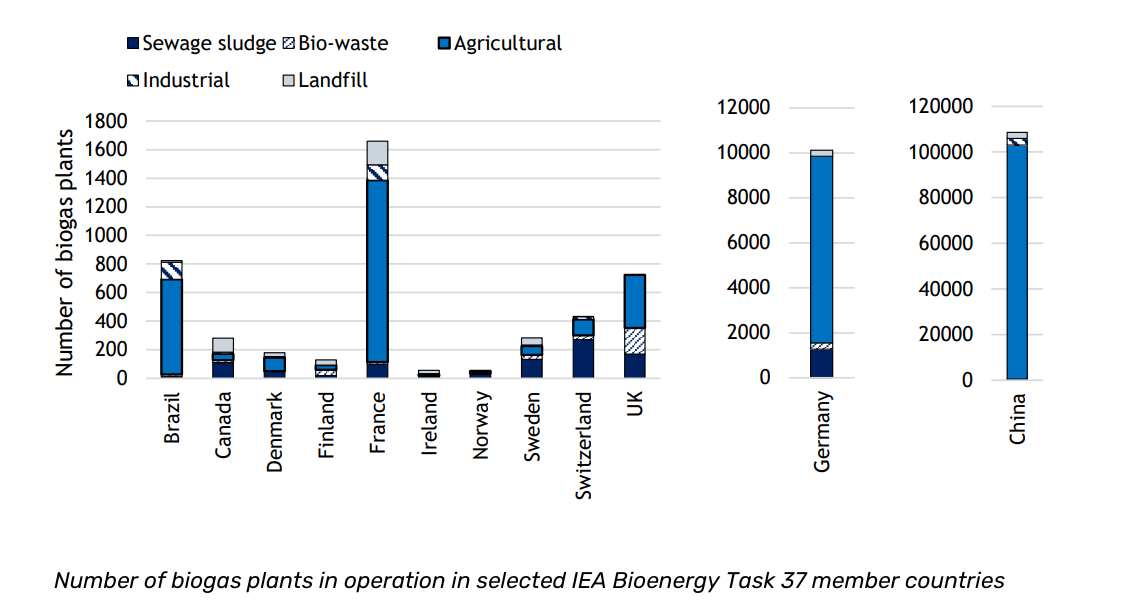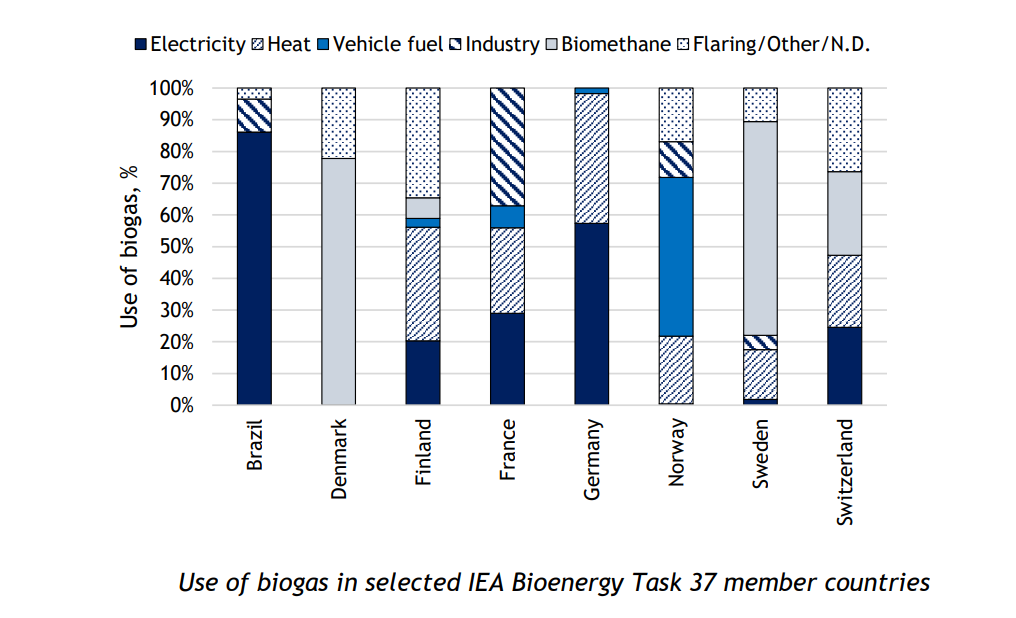At the end of last year, IEA Bioenergy developed a report on biogas and biomethane production, the use of biogas and other anaerobic digestion products, political and financial conditions, as well as innovative projects in the member countries of the International Energy Agency (IEA): Brazil, Canada, China, Denmark, Finland, France, Germany, Ireland, Norway, Sweden, Switzerland, and the United Kingdom.
Important aspects of the report
Number of plants
China has the highest number of biogas plants among the reporting IEA Bioenergy Task 37 member countries, with more than 100,000 biogas plants, followed by Germany with over 10,000 and France with over 1,600 plants. Of the other reporting countries, Brazil has more than 800 biogas plants, UK has over 700 and the others have less than 500. With the exception of China, these are total numbers and include digesters of all sizes and technical configurations.

Source: IEA Bioenergy.
Biogas production
Germany has the highest annual biogas production, around 87 TWh/y. China produces around 81 TWh per year, UK 32 TWh, France 25 TWh, Brazil 12 TWh and Denmark 7 TWh. The other reporting countries produce less than 3 TWh.
Types of plants
In Finland, Norway, Sweden, Switzerland and Canada, both wastewater treatment plants (WWTP) and plants based on mixed bio-waste play a more substantial role in biogas production than in other reporting countries. Agricultural plants constitute the majority of the biogas produced in China, Denmark, France and Germany. Landfilling of organic waste is being phased out in many countries, but landfill gas continues to be produced for many years and is the largest source of biogas in Brazil, Ireland and Canada.
Upgrading to biomethane
Only half of the countries provided up-to-date data, but membrane technology is the most common. With 364 upgraders, France also has the highest number of upgrading plants among the reporting countries.

Source: IEA Bioenergy.
Use of biogas
Electricity and heat generation are the most common uses of biogas in Germany, Brazil, Canada, France and Finland. In Denmark and Switzerland, a large share of the produced biogas is upgraded into biomethane and injected into the gas grid. Sweden and Finland also have notable shares of biomethane production, but there it is mainly used as vehicle fuel, either as compressed (bio-CNG) or liquefied (bioLNG) gas. Industrial use is relatively common in France, Norway and Brazil.

Source: IEA Bioenergy.
Policy frameworks and financial conditions
The conditions for biogas development depend on each country’s energy and industrial infrastructure and its objectives related to clean energy, climate change and waste management. Subsidizing electricity production from biogas through feed-in-tariffs has served as a common starting point in many European countries and North America, and is still the predominant support system in Brazil. Although biogas is used for heat, especially in WWTP and industrial biogas plants, only Ireland and France noted programs that support AD for heat production.
The UK has recently closed its Renewable Heat Incentive program. In recent years, in most European countries, Brazil and North America, the focus of biogas support has been shifting towards biomethane production for grid injection or for use as vehicle fuel. Sweden, Norway and Finland use tax exemptions for biogas use and investment support for new biogas plants as their main financial instruments. Many European countries have incentives for producing biogas from manure to mitigate agricultural methane emissions, and China has supported numerous AD demonstration projects for different types of manure.
Technical progress and innovation
There is a lot of promising technical progress and innovation in the biogas sector, with projects from food grade CO₂ production to sustainable aviation fuel. In particular, there are many examples of projects aiming to exploit the biogas potential in lignocellulosic biomass, to increase the conversion of CO2 via methanation and power-to-gas, as well as projects that are investigating greater use of straw and intermediate crops in AD. Along with innovative system integration projects, these examples reflect growing momentum in this space, and increased societal relevance for the biogas sector in the future.
Download the full report by IEA Bioenergy (in English)
Producing and using biogas through anaerobic digestion (AD) is a unique way of addressing multiple sustainability issues at the same time, including renewable energy production, waste management, climate change mitigation, and sustainable agriculture. In addition, AD by-products can have additional positive effects. Digestate — the liquid or semi-solid residue after processing the raw material — retains undecomposed carbon and almost all the nutrients of the original raw material and can be used as a soil fertilizer.
Source: IEA Bioenergy.